
Pricing is a very crucial aspect of every business. Optimized pricing strategy ensures greater profitability, and competitiveness. Manual pricing adjustment has become increasingly irrelevant due to continuously changing market trends and shifting consumer behaviors. That’s where the pricing software and tools come into play.
Modern solutions for pricing software incorporate AI, machine learning, and real-time data analytics that will help companies set the right price, track their competitors, and dynamically price their offerings. Whether you are a retailer or a manufacturer, the right pricing tool will bring much needed insight and automation capabilities to drive efficiency and revenue growth.
The 10 best pricing software and tools to consider in 2025 are listed in this blog. Every software is designed to tackle a distinct pricing problem, ranging from AI-poweredprice optimization to competition price monitoring. You may make an informed choice that supports your company’s objectives by being aware of their characteristics andadvantages.
Why Do You Need a Competitive Pricing Tool?
A competitive pricing tool is indispensable in business operations that eye strategic pricing to outcompete others in the dynamically changing market. These tools enable a business to track competitors’ prices in real time, understand the market trend, and thereby automate the process of adjusting prices according to demand and competition. Without a competitive pricing tool a business may lag behind in catching the ball of pricing fluctuation which result in either missed revenue opportunities or overpricing issues that will drive customers away.
Through this competitive pricing tool businesses will be able to make data driven decisions that further improve their profit margins and competitive edge. The dynamic pricing strategy could be executed in a company due to the capability of these tools to ensure correct pricing at the right time.
Types of Pricing Tools?
Different businesses and industries require different varieties of pricing tools. Some important types and their niches include:
- Dynamic Pricing Tools: These mainly find their application in e-commerce and retail sectors, where prices are changed on demand, competitors’ pricing, and market conditions. Example includes Prisync.
- Competitor Price Monitoring Tools: Those tools continuously track your competitors’ prices and help a business set prices competitively. Example: Price2Spy.
- AI-Powered Price Optimization Tools: These tools use AI and machine learning to suggest the best price considering a variety of data points. Example: Competera.
- Price Management Tools: This kind of tool is required for an enterprise-level pricing strategy, which will help a business manage multi-region pricing and large- scale price adjustments. Example: Pricefx.
- Repricing Software: These tools are often deployed in marketplaces like Amazon to automatically adjust your prices to keep them competitive. Example: BlackCurve.
- B2B Pricing Solutions: These are for manufacturers, wholesalers, and distributors who need advanced pricing regarding client segments and contracts. Example: Vendavo.
Best Pricing Software and Tools to consider in 2025
1. Pricefx
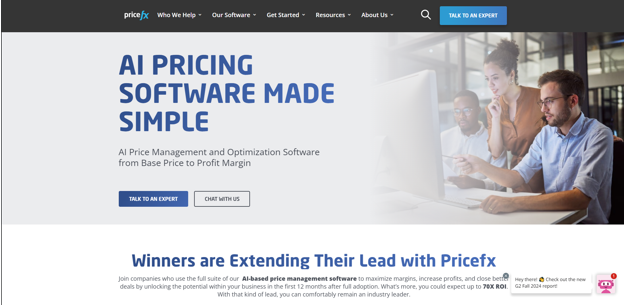
Pricefx is a cloud-based pricing software that offers a complete pricing solutions for companies of all sizes. It helps companies execute real time price optimization strategies with AI-driven insights which is always competitive in dynamic markets.
Because of its good integration with current enterprise resource planning and customer relations systems, firms can quickly review pricing data and modify their pricing plans as necessary. Pricefx is an ideal option for any business looking for a flexible and effective pricing solution because of its simple user interface and versatile pricing systems.
Best For: AI-driven dynamic pricing solutions
Features:
- AI-powered pricing optimization
- Real-time competitive analysis
- Customizable pricing models
- Cloud-based scalability
Pros:
- Easy integration with ERP and CRM
- AI-driven insights for pricing strategies
- Fast implementation process
- Excellent customer support
Cons:
- Premium pricing for small businesses
- Requires training to maximize benefits
2. Prisync
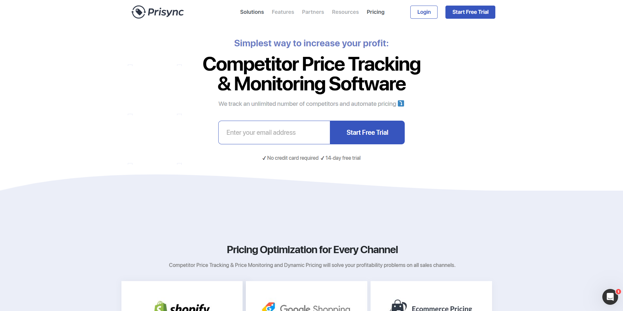
Prisync is a powerful e-commerce pricing tool that enables businesses to manage their pricing plan and monitor competition prices. To help online merchants remain ahead of the competition, it provides detailed analytics and immediate rival monitoring.
Businesses can respond promptly to market changes by using Prisync to receive automated notifications when competitors alter their prices. The platform’s automation features save a great deal of time and improve accuracy by doing away with human price tracking. For e-commerce companies that operate in very competitive markets, it is especially helpful.
Best For: E-commerce price monitoring and repricing
Features:
- Competitor price tracking
- Automated dynamic pricing
- Customizable reporting
- API for seamless integration
Pros:
- Affordable pricing plans
- Easy setup and user-friendly dashboard
- Great for SMBs and large enterprises
- Provides in-depth market insights
Cons:
- Limited advanced AI-driven pricing
- Some data accuracy issues
3. Competera
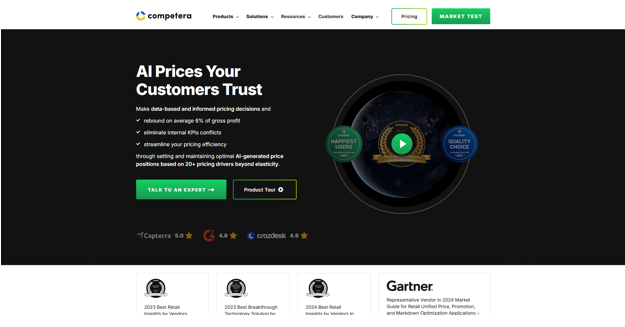
Competera is an AI-powered software for pricing optimization that assists businesses and merchants in improving their prices using the best ways. Competera uses deep learning algorithms to examine consumer demand, market trends, and rival pricing in order to suggest the best price points.
Price testing based on rules pricing strategy development and analytics on how pricing choices affect a company’s sales success are all made easier with this tool. Competera will be able to maintain price competitiveness while optimizing revenue, regardless of the size of the business.
Best For: AI-powered price optimization for retailers
Features:
- AI-driven pricing recommendations
- Competitive price monitoring
- Rule-based pricing automation
- Price testing and analytics
Pros:
- Advanced AI-based pricing models
- Improves profit margins with automation
- Highly scalable for large businesses
- Excellent data-driven insights
Cons:
- Higher pricing for premium features
- Requires technical expertise for setup
4. Omnia Retail
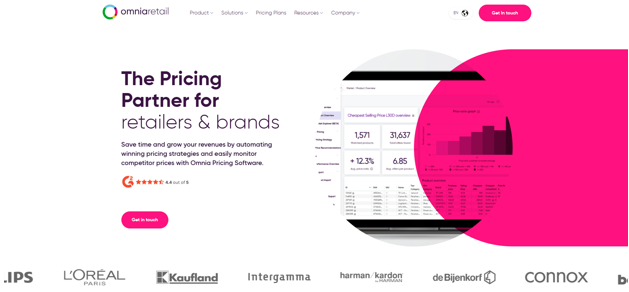
Omnia Retail is an all-in-one price and marketing automation platform for retailers, offering real-time price intelligence, automated price adjustments, and competitor analysis to optimize pricing strategies.
Among the most outstanding options, Omnia Retail offers integration with a digital marketing platform to ensure smooth alignment in pricing and promotion. This solution fits all multi-channel retailers who look to improve and automate the pricing process as much as possible.
Best For: Automated pricing and marketing for retailers
Features:
- Dynamic pricing engine
- Competitive market analysis
- Automated price adjustments
- Pricing rule configurator
Pros:
- Strong automation features
- Flexible pricing rules
- Great for multi-channel retailers
- Integrates with marketing automation
Cons:
- Requires customization for industry-specific needs
- Can be costly for startups
5. Zilliant
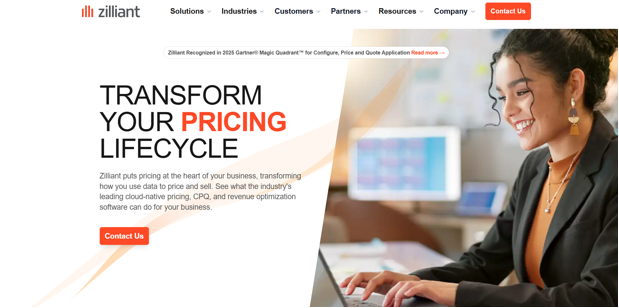
Zilliant is cloud-based pricing optimization software that utilizes AI and predictive analytics to guide intelligent pricing actions for businesses. It provides real-time pricing guidance and revenue optimization solutions.
Zilliant is quite widespread among various B2B industries: manufacturing, distribution, and services with complex pricing, which require decisions based on the data. In this case, the platform may enable businesses to improve margins and increase sales and enhance pricing efficiency.
Best for: For large enterprises that want to improve their pricing and profitability.
Key Features:
- Price optimization
- Deal management
- Margin analysis
- Integration with ERP and CRM systems
Pros:
- Price optimization
- Deal management
- Margin analysis
- Integration with ERP and CRM systems
Cons:
- High implementation costs
- Not suitable for small businesses
6. Vendavo

Vendavo is an enterprise level pricing tool that helps businesses improve their income and pricing strategies. It offers data based ideas on how to increase profit margins and make better pricing decisions driven by AI insights.
It also provides solutions on CPQ, margin optimization, and price segmentation, making Vendavo perfect for large enterprises dealing with complex pricing structures. In addition, advanced analytics and automation included in the platform help the business to be ahead in the competitive markets.
Best For: Enterprise-level price and revenue management
Features:
- AI-powered price optimization
- CPQ (Configure, Price, Quote) solution
- Data-driven analytics
- Customer price segmentation
Pros:
- Designed for large enterprises
- Improves margin efficiency
- AI-enhanced decision-making
- Advanced analytics dashboard
Cons:
- High implementation cost
- Steep learning curve
7. Price2Spy
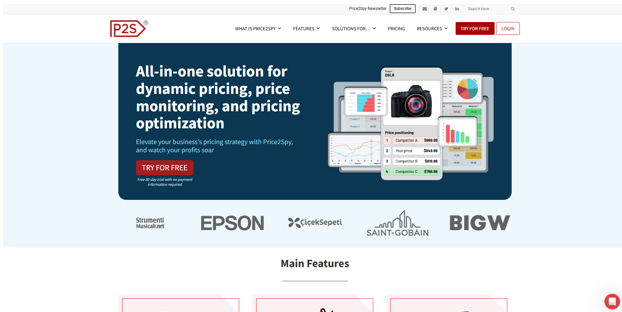
Price2Spy was built as a competitive price monitoring tool for e-commerce. It offers real-time competitors’ price tracking, reworking pricing strategies based on the obtained data, and historical pricing trends analysis.
The automated repricing, which the platform offers, means it’s able to set up predefined rules whereby price changes happen based on market conditions. With an easy- to-use interface, a range of price plans means Price2Spy is well-placed to help online retailers stay competitive.
Features:
- Price comparison and tracking
- Automated price updates
- API access for integrations
- Reporting and analytics
Pros:
- Affordable for small businesses
- Real-time competitor monitoring
- Simple and intuitive interface
- Customizable reporting tools
Cons:
- Limited AI-driven pricing optimization
- Requires manual adjustments for best results
8. BlackCurve
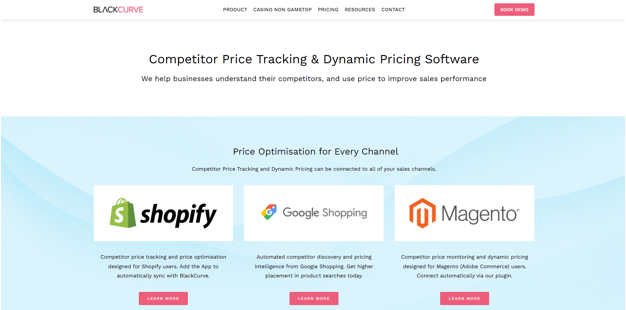
BlackCurve is an AI-driven price optimization tool to help retailers and e-commerce make data driven pricing decisions. It uses machine learning algorithms in the analysis of market conditions and provides recommendations on the most optimal price points.
This tool helps companies improve profitability with features like automated price adjustments, competitor tracking, and margin optimization. This platform is quit efficient in businesses that are involved in highly dynamic and sensitive industries.
Best For: AI-powered retail pricing strategies
Features:
- Machine learning-based price recommendations
- Competitor tracking and analysis
- Automated price adjustments
- Profit margin optimization
Pros:
- AI-driven insights improve pricing accuracy
- Easy-to-use dashboard
- Works well for retailers
- Competitive market insights
Cons:
- Can be costly for small businesses
- AI recommendations may require adjustments
9. PriceEdge
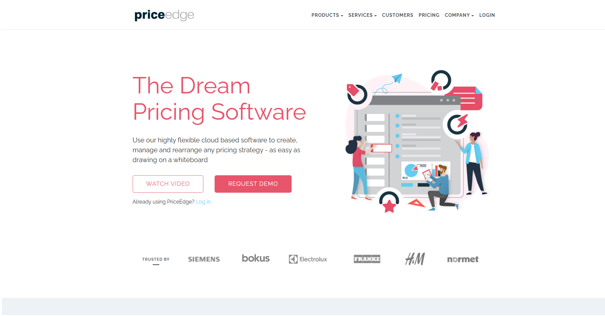
PriceEdge is an agile enterprise pricing software built for companies in need of advanced analytics and optimization. It features multi-region pricing management, customizable pricing rules, and data-based insights.
With PriceEdge, organizations can establish dynamic pricing models appropriate for different markets and customer segments. The intuitive dashboard and integration capabilities make it one of the more valuable assets that businesses can find to optimize their pricing strategies worldwide.
Best For: Flexible pricing software for enterprises
Features:
- Pricing analytics and reports
- Dynamic price optimization
- Multi-region pricing management
- Customizable pricing rules
Pros:
- Scalable solution for enterprises
- Strong analytics for price setting
- Supports multiple industries
- User-friendly interface
Cons:
- Requires training to utilize fully
- Higher price for premium features
10. Symson
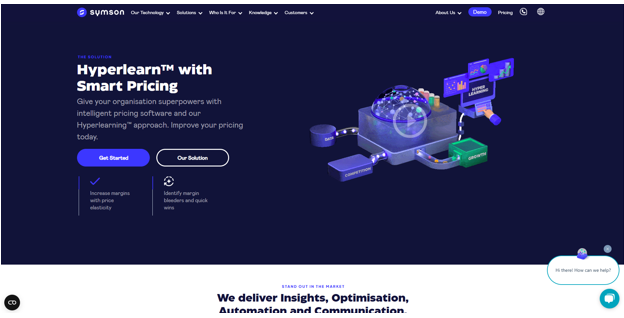
Symson is an AI-powered pricing management tool that will instantly change your business with the moving market. In this tool, manage and control the competitive benchmark, automated pricing rules, and demand forecasting.
With this software, your business will outpace competitors due to profound insights into pricing trends and customer behavior. Through its AI-powered approach, Symson makes certain that businesses execute the best price that provides the right profitability.
Best For: AI-based price management solutions
Features:
- AI-driven pricing models
- Competitive price benchmarking
- Rule-based price automation
- Market demand forecasting
Pros:
- Uses advanced AI for price optimization
- Real-time price monitoring
- Customizable pricing strategies
- Good customer support
Cons:
- High learning curve
- Expensive for small businesses
Conclusion:
In today’s world with ever changing dynamics of pricing and competition, the right pricing software could be a game changer for any business. The best pricing software and tools in 2025 drive optimum pricing strategy with AI and data analytics to maximize revenue for businesses.
Whether it is for best-in-class pricing software to perform real-time competitor tracking, AI-driven pricing recommendations, or automated price adjustments, the aforementioned tools provide different features to answer the different business needs. The ability to compare these pricing solutions on capability, scalability, and integration options enables businesses to make informed decisions that will enhance profitability and ensure their long-term success in an increasingly competitive market.







